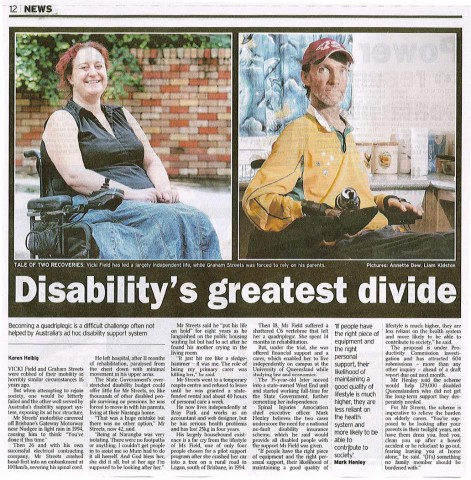Tale Of Two Recoveries
The following article by Korin Helbig posted in the Courier Mail reaching millions of readers on January 4th 2011 emphasizes the life-long benefit of early funding and support after spinal cord injury.
Vicki Field and Graham Streets were robbed of their mobility in horribly similar circumstances 16 years ago. But when attempting to rejoin society, one would be bitterly failed and the other well served by Australia’s disability support system, exposing its ad hoc structure.
Mr Streets’ motorbike careered off Brisbane’s Gateway Motorway near Nudgee in light rain in 1994, causing him to think: ”You’ve done it this time.”

Then 26 and with his own successful electrical contracting company, Mr Streets crashed head-first into an embankment at 100km/h, severing his spinal cord. He left hospital, after 11 months of rehabilitation, paralysed from the chest down with minimal movement in his upper arms.
The State Government’s overstretched disability budget could offer little for Mr Streets, so, like thousands of other disabled people surviving on pensions, he was forced to move in with his parents, living at their Narangba home.
”That was a huge mistake but there was no other option,” Mr Streets said. ”Being at Narangba was very isolating. There were no footpaths or anything. I couldn’t get people in to assist me so Mum had to do it all herself. And God bless her, she did it all but at her age, I’m supposed to be looking after her.”
Mr Streets said he ”put his life on hold” for eight years as he languished on the public housing waiting list but had to act after he found his mother crying in the living room. ”It just hit me like a sledgehammer – it was me. The role of being my primary carer was killing her,” he said.
Mr Streets went to a temporary respite centre and refused to leave until he was granted a state-funded rental and about 40 hours of personal care a week.
He now lives independently at Bray Park and works as an accountant and web designer, but he has serious health problems and has lost 25kg in four years.
His largely housebound existence is a far cry from the lifestyle of Ms Field, one of only four people chosen for a pilot support program after she crashed her car into a tree on a rural road in Logan, south of Brisbane, in 1994.
Then 18, Ms Field suffered a shattered C6 vertebrae that left her a quadriplegic. She spent 14 months in rehabilitation.
But, under the trial, she was offered financial support and a carer, which enabled her to live independently on campus at the University of Queensland while studying law and economics.
Vicki later moved into a state-owned West End unit and started working full-time for the state government, further cementing her independence.
Spinal Injuries Association chief executive officer Mark Henley believes the two cases underscore the need for a national no-fault disability insurance scheme, which he said would provide all disabled people with the support Ms Field was given.
”If people have the right piece of equipment and the right personal support, their likelihood of maintaining a good quality of lifestyle is much higher, they are less reliant on the health system and more likely to be able to contribute to society,” he said.
The proposal is under Productivity Commission investigation and has attracted 604 submissions – more than any other inquiry ahead of a draft report due out next month.
Mr Henley said the scheme would help 129,000 disabled Queenslanders who did not get the long-term support they desperately needed.
For Mr Streets, the scheme is imperative to relieve the burden on elderly carers. ”You’re supposed to be looking after your parents in their twilight years, not have them dress you, feed you, clean you up after a bowel accident or be reluctant to go out, fearing leaving you at home alone,” he said.
”(It’s) something no family member should be burdened with.”
Korin Helbig
Reporter, Courier Mail
Resources
- Pictures: Annette Dew, Liam Kidston.
- Source: The Courier-Mail; http://www.couriermail.com.au
Recent Comments